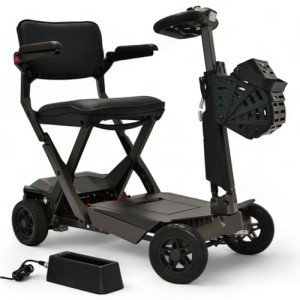The Most Advanced Guide To Mobility Scooter

A Comprehensive Guide to Buying a Mobility Scooter
Mobility scooters have ended up being an essential tool for lots of individuals looking to improve their independence and mobility. With a huge array of designs and features offered, selecting the best mobility scooter can be daunting. This article offers a helpful guide to help customers navigate their alternatives, evaluate their requirements, and make a notified purchase.
Comprehending Mobility Scooters
Mobility scooters are electric lorries developed for individuals who experience mobility challenges. They are particularly useful for seniors, those with specials needs, or individuals recovering from injuries. Mobility scooters can differ extensively in regards to style, features, and rates.
Types of Mobility Scooters
Before starting a purchase, it's important to comprehend the various kinds of mobility scooters readily available:
Three-Wheel Scooters:
- Generally more maneuverable in tight areas
- Lightweight and portable
- Ideal for indoor use
Four-Wheel Scooters:
- Offer greater stability and balance
- Suitable for outdoor usage over various terrains
- Generally have a longer battery life
Foldable/Portable Scooters:
- Designed to be easily carried and saved
- Can typically suit the trunk of a vehicle
- Suitable for those who travel frequently
Durable Scooters:
- Built to accommodate bigger individuals
- Typically come with more robust functions for outdoor usage
- Usually geared up with bigger batteries for extended range
Aspects to Consider When Buying a Mobility Scooter
1. Weight Capacity
Pick a mobility scooter that can support the user's weight. Many scooters have a weight limitation varying from 250 to 500 pounds. It is important to guarantee that the scooter can accommodate the user comfortably.
2. Variety and Battery Life
The range is how far the mobility scooter can take a trip on a single charge. Normal varieties vary between 10 to 30 miles. Think about the user's daily activities and pick a scooter with an ideal variety.
3. Scooter Dimensions
Think about the size of the scooter, including its weight and measurements. pop over here might be ideal for narrow corridors and tight spaces, while bigger models use extra stability and convenience.
4. Surface Capability
Examine where the scooter will primarily be used. If the user plans to travel primarily on pavement, a lightweight model may be adequate. Nevertheless, if the user needs to traverse gravel or uneven surfaces, think about a four-wheel scooter built for off-road use.
Leading Features to Look For
Comfort
- Adjustable Seats: Look for scooters with cushioned and height-adjustable seats to ensure convenience during travel.
- Armrests: These improve safety and assistance while browsing.
Safety and Visibility
- Headlights and Taillights: Essential for nighttime use.
- Turn Signals and Reflectors: Improve presence and security while on the roadway.
User-Friendly Controls
- Joystick or Drive Controls: These ought to be user-friendly and simple to manipulate.
- Easy-to-Read Displays: A control panel that shows battery life, speed, and range can boost the user experience.
Extra Features
- Storage Compartments: These provide included convenience for bring personal items while on the go.
- Weather condition Protection: Consider designs with rain covers or windscreens if used in variable weather condition conditions.
Expense Considerations
When budgeting for a mobility scooter, rates can range anywhere from ₤ 500 to over ₤ 5,000 depending upon the design, functions, and brand. Extra costs might include:
- Extended Warranty: Protects against problems and can conserve money in the long run.
- Devices: Optional functions, such as upgraded seats, lights, or storage options.
| Feature | Cost Range |
|---|---|
| Standard Models | ₤ 500 - ₤ 1,500 |
| Mid-Range Models | ₤ 1,500 - ₤ 3,000 |
| High-End Models | ₤ 3,000 - ₤ 5,000 |
Financing Options
Numerous sellers use funding strategies, and some city government efforts might supply grants or assistance for those in requirement. Examine potential financial help with neighborhood resources or mobility service organizations.
Frequently asked questions about Buying a Mobility Scooter
What is the difference in between a mobility scooter and a wheelchair?
Mobility scooters are motorized and permit users to navigate independently, while wheelchairs may need physical support or manual operation.
How do I preserve a mobility scooter?
Routine maintenance includes checking battery life, cleaning up the scooter, and inspecting tires and brakes. Always describe the user manual for specific guidelines.
Can mobility scooters be used inside your home?
Yes, lots of models are developed for both indoor and outside usage. Nevertheless, three-wheel scooters tend to be better matched for indoor navigation due to their tighter turning radius.
Are mobility scooters covered by insurance coverage?
Some insurance coverage prepares cover a part of the costs for mobility scooters if they are deemed medically required. Contact your service provider for specific information.
How quick can a mobility scooter go?
The majority of mobility scooters have an optimal speed varying from 4 to 8 mph. However, the suitable rate may vary depending on local policies.
Acquiring a mobility scooter can substantially enhance one's independence and lifestyle. By comprehending the types, features, and expenses related to mobility scooters, prospective buyers can make educated choices that fit their requirements and preferences. Personalization and extensive research study are key to guaranteeing complete satisfaction with this essential financial investment.

